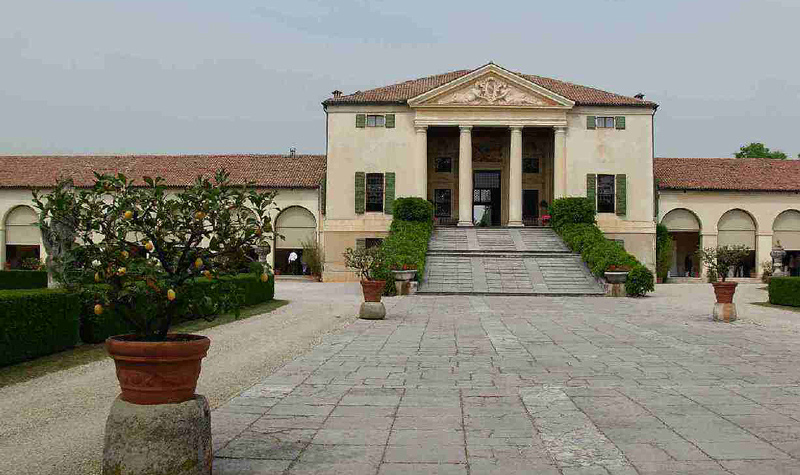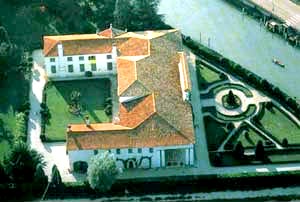
Veneto Villas
Venezia.net has made a detailed research on the most important villas in Venice and the Veneto surroundings. We have grouped Veneto Villas according to some itineraries (you can see the table on the right) and have briefly described them, proposing also two reference maps showing the tourist journeys. The great season of the villas of the Veneto lasted good four centuries, from the half of the fifteenth century to the half of the nineteenth century.
Structure of the Villa
 The hinge – physical and conceptual – of the house was always the large central hall of the noble floor. That was the ‘stage’ of family life, where friends and visitors were welcomed, where people could enjoy concerts and theatre. Here the family represented itself by showing taste and wealth. So that was the largest and the richest room in the house, usually placed in the centre of the master’s house (and often on two floors), it was painted in fresco by well known painters and furnished with the best furniture. In comparison with it the other rooms were much less important.
People wanted large, rich and well decorated rooms, endowed with a beautiful and wide view on the surrounding park too. Their arrangement was generally uncomfortable because of the symmetrical plant of the building giving rise to symmetrically arranged rooms.
On the lower floor (or basement if there was one) there were the kitchens and the other service rooms. The toilet (or what was taken as that) was obtained on the hidden corners.
Some other structures
Near the house, intended for the master’s residence, there were the buildings of the farm, which was always present with the residences closer to towns, that were apparently intended only for mere holidays. And here Veneto worked out a particular invention which deeply characterized the country houses of this region: the ‘barchessa’, namely a compact structure generally prolonged, where people could put together all their rustic exigencies. It was an innovation of prime importance as it could give an architectonic and aulic shape todemands which had been so far considered unworthy of that honour; on the contrary they needed to be concealed. That supplied the villa in Veneto, usually composed of the union of the master’s house and the barchessa, with an identity
The hinge – physical and conceptual – of the house was always the large central hall of the noble floor. That was the ‘stage’ of family life, where friends and visitors were welcomed, where people could enjoy concerts and theatre. Here the family represented itself by showing taste and wealth. So that was the largest and the richest room in the house, usually placed in the centre of the master’s house (and often on two floors), it was painted in fresco by well known painters and furnished with the best furniture. In comparison with it the other rooms were much less important.
People wanted large, rich and well decorated rooms, endowed with a beautiful and wide view on the surrounding park too. Their arrangement was generally uncomfortable because of the symmetrical plant of the building giving rise to symmetrically arranged rooms.
On the lower floor (or basement if there was one) there were the kitchens and the other service rooms. The toilet (or what was taken as that) was obtained on the hidden corners.
Some other structures
Near the house, intended for the master’s residence, there were the buildings of the farm, which was always present with the residences closer to towns, that were apparently intended only for mere holidays. And here Veneto worked out a particular invention which deeply characterized the country houses of this region: the ‘barchessa’, namely a compact structure generally prolonged, where people could put together all their rustic exigencies. It was an innovation of prime importance as it could give an architectonic and aulic shape todemands which had been so far considered unworthy of that honour; on the contrary they needed to be concealed. That supplied the villa in Veneto, usually composed of the union of the master’s house and the barchessa, with an identity  resulting completely different from that one peculiar of other regions.
The garden
On the back of the house there was the ‘brolo’, namely the garden: it was the most important among all the attractive features forthe Venetians who spent their lives in town, shut up in the stones of their houses and the sea waves, with not many opportunities of admiring open and boundless green areas.
Architecture
The creation of an architectural casing typical of the villa, not deriving from building standards, appeared in the sixteenth century thanks to the brilliant idea of Palladio. He gave shape to the ‘loggia’, namely the idea of placing a colonnade opening the rooms on the outside, before the central part of the house, in connection with the main hall.
The era of the villas did not end simply with the construction of wonderful buildings. The Villas marked the beginning of land reclamation and agricultural centres as well as of new canals and roads. Their extraordinary architectural structure encouraged and brought about an intense flourishing of all decorative arts related to architecture: sculpture and painting, ornaments painted in fresco and cabinet making, garden art and regulations of water necessary to fountains, fish-ponds and small lakes.
resulting completely different from that one peculiar of other regions.
The garden
On the back of the house there was the ‘brolo’, namely the garden: it was the most important among all the attractive features forthe Venetians who spent their lives in town, shut up in the stones of their houses and the sea waves, with not many opportunities of admiring open and boundless green areas.
Architecture
The creation of an architectural casing typical of the villa, not deriving from building standards, appeared in the sixteenth century thanks to the brilliant idea of Palladio. He gave shape to the ‘loggia’, namely the idea of placing a colonnade opening the rooms on the outside, before the central part of the house, in connection with the main hall.
The era of the villas did not end simply with the construction of wonderful buildings. The Villas marked the beginning of land reclamation and agricultural centres as well as of new canals and roads. Their extraordinary architectural structure encouraged and brought about an intense flourishing of all decorative arts related to architecture: sculpture and painting, ornaments painted in fresco and cabinet making, garden art and regulations of water necessary to fountains, fish-ponds and small lakes.